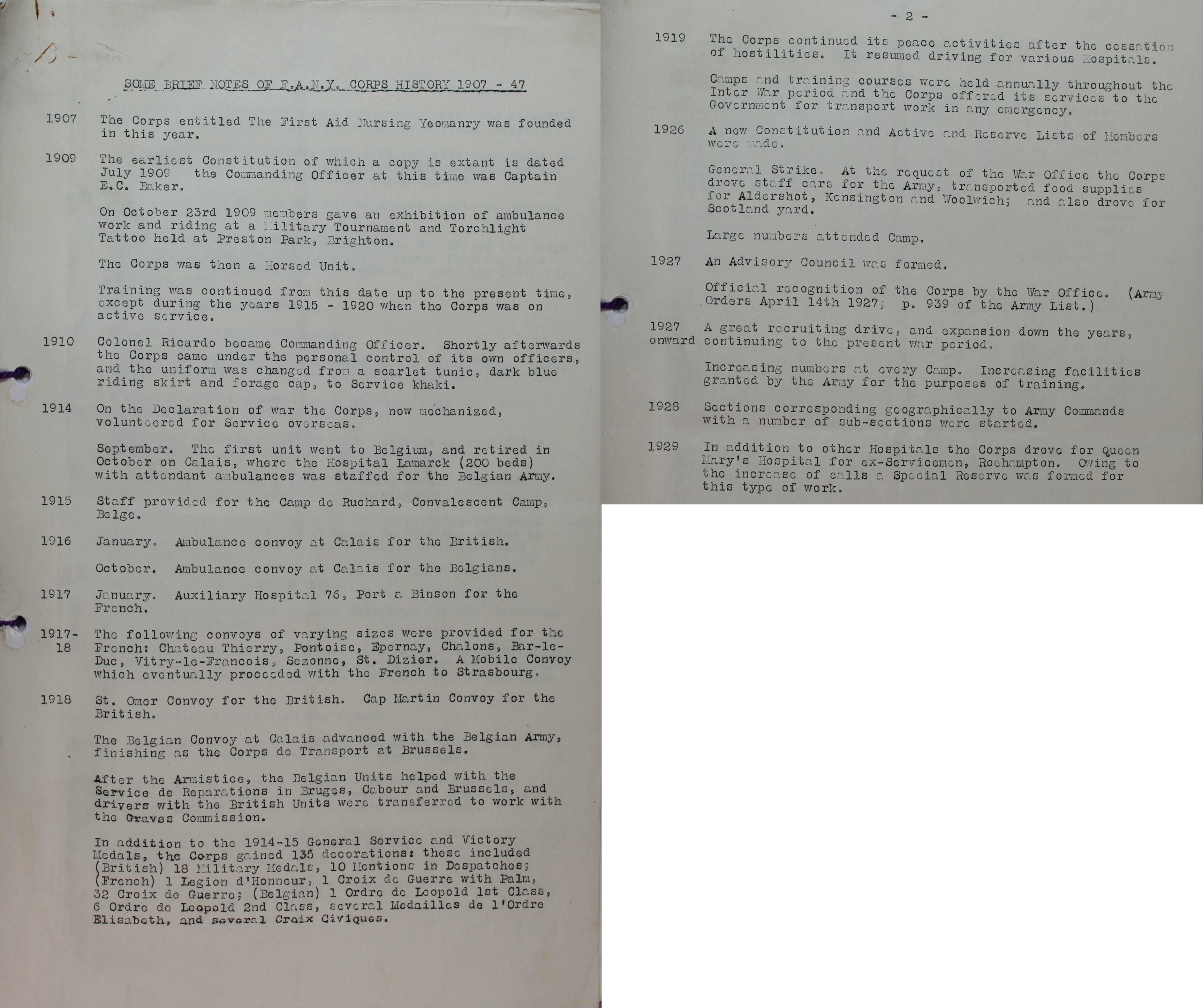
This is an extract from a document which is part a collection of histories and war diaries (1944-1954) within the Special Operations Executive. The whole document outlined the history of the First Aid Nursing Yeomanry (FANY) corps 1907-1947. (Catalogue ref: HS 7/7)
Transcript
SOME BRIEF NOTES OF F.A.N.Y. CORPS HISTORY 1907-1947
| 1907 | The Corps entitled The Voluntary Aid Nursing Yeomanry was founded in this year. |
| 1909 | The earliest constitution of which a copy is extant is dated July 1909 the Commanding Officer at this time was Captain E. C. Baker.
On October 23rd 1909 members gave an exhibition of ambulance work and riding at a Military Tournament and Torchlight Tattoo held at Preston Park, Brighton. The Corps was then a Horsed unit. Training was continued from this date up to the present time, except during the years 1915-1920 when the Corps was on active service. |
| 1910 | Colonel Ricardo became Commanding Officer. Shortly afterwards the Corps came under the personal control, of its own officers, and the uniform was changed from a scarlet tunic , dark blue riding skirt and forage cap, to Service khaki. |
| 1914 | On the declaration of war the Corps, now mechanized, volunteered for Service overseas. September. The first unit went to Belgium, and retired in October on Calais, where the Hospital Lamarck (200 beds) with attendant ambulances was staffed for the Belgium Army. |
| 1915 | Staff provided for the Camp de Ruchard, Convalescent Camp, Belgium |
| 1916 | January. Ambulance convoy at Calais for the British
October. Ambulance convoy at Calais for the Belgians. |
| 1917 | January. Auxiliary Hospital 76, Port a Binson for the French. |
| 1917-18 | The following convoys of various sizes were provide for the French: Chateau Thiery, Pontoise, Epernay, Chalons, Bar-le-Duc, Vitry-le-Francois, Sezanne, St.Dizier. A mobile Convoy which eventually proceeded with the French to Strasburg. |
| 1918 | St. Omer Convoy for the British. Cap. Martin Convoy for the British.
The Belgium Convey at Calais advanced with the Belgian Army, finishing as the Corps de Transport at Brussels.
After the Armistice, the Belgian Units helped with the Service de Reparations in Bruges, Cabour and Brussels, and drivers with the British Unit were transferred to work with Graves Commission.
In addition to the 1914-1915 General Service and Victory Medals, the Corps gained 135 decorations: these included (British) 18 Military Medals, 10 Mentions in Despatches; (French) 1 Legion of Honneur, 1 Croix de Guerre with Palm, 32 Croix de Guerre; (Belgian) 1 Order de Leopold 1st Class, 6 Ordre de Leopold 2nd Class, several Medailles de l’ordre Elisabeth, and several Croix Civiques. |
| 1919 | The Corps continued its peace activities after the cessation of hostilities. It resumed driving for various Hospitals. Camps and training courses were held annually throughout the Inter war period and the Corps offered its services to the Government for transport work in any emergency. |
| 1926 | A new constitution and Active and Reserve Lists of Members were made.
General Strike. At the request of the War Office the Corps drove staff cars for the Army, transported food supplies for Aldershot, Kensington and Woolwich; and also drove for Scotland yard. Large numbers attended camp. |
| 1927 | Advisory council was formed. Official recognition of the Corps by the War Office. (Army Orders April 14th 19127; p.939 of the Army List.) |
| 1927 onward | A great recruiting drive, and expansion down the years continuing to the present war period. Increasing numbers at every Camp. Increasing facilities granted by the Army for the purposes of training. |
| 1928 | Sections corresponding geographically by Army Commands with a number of sub-sections were started. |
| 1929 | In addition to other Hospitals the Corps drove for Queen Mary’s Hospital, Roehampton for ex-servicemen, Roehampton. Owing to the increase of calls a Special Reserve was formed for this type of work. |
